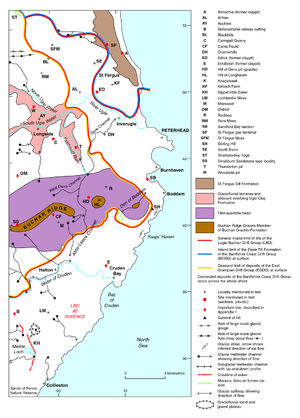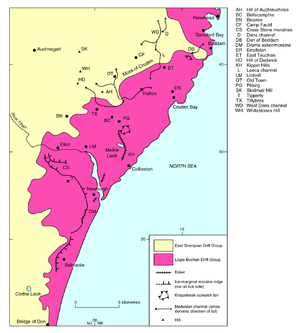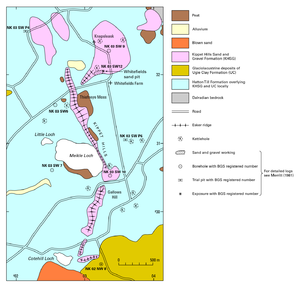Kippet Hills, Slains - locality, Cainozoic of north-east Scotland
| Merritt, J W, Auton, C A, Connell, E R, Hall, A M, and Peacock, J D. 2003. Cainozoic geology and landscape evolution of north-east Scotland. Memoir of the British Geological Survey, sheets 66E, 67, 76E, 77, 86E, 87W, 87E, 95, 96W, 96E and 97 (Scotland).
Contributors: J F Aitken, D F Ball, D Gould, J D Hansom, R Holmes, R M W Musson and M A Paul. |
Kippet Hills, Slains

The Late Devensian sands, gravels and tills at Kippet Hills provide important evidence concerning the direction of movement of ice that laid down the Logie-Buchan Drift Group and the pattern of deglaciation in the coastal lowlands north of Aberdeen. In particular, the presence of marine shells of Early Pleistocene age, together with clasts of sandstone, dolomite, limestone and shale in the Kippet Hills Esker (P219697), indicate that much of the glaciofluvial gravel was initially derived from offshore.


The Kippet Hills area, 7 km east of Ellon on Sheet 87E (P915377, P915297), includes ridges and hummocky terrain underlain by the Kippet Hills Sand and Gravel Formation of the Logie-Buchan Drift Group (P915320). These landforms and deposits have been the focus of research and controversy for more than 150 years (Gordon, 1993b). In particular, the presence of unusual clasts, such as pebbles of Cretaceous flint and Jurassic limestone, as well as shells of Early Pleistocene marine molluscs in the sands and gravels have resulted in a variety of interpretations of their origin. They have been explained as in situ Crag deposits of marine origin, formed during the late Tertiary (Jamieson, 1858), as marine deposits ploughed up by ice into their present topographic form (Jamieson, 1865) and as glacigenic deposits (Jamieson, 1882a). Wilson (1886) suggested that the sands and gravels were interglacial marine beds, equivalent to those at Clava and King Edward, but that red clays overlying the sands and gravels were of glacial origin. Bell (1895) concluded that both the shelly gravels and the clays were glacial deposits, but Hull (1895) disagreed with Bell’s interpretation and invoked marine submergence to explain both the clays and the sands and gravels.
It is now generally accepted that the Kippet Hills area contains landforms, including esker ridges, kames, terraces and kettleholes, that were formed by glaciofluvial deposition during the melting of the Late Devensian ice sheet (Gemmell, 1975; Merritt, 1981; Smith, 1984; Hall and Jarvis, 1995). The landforms and sediments provide important clues as to the directions of ice movement and the pattern of deglaciation in the coastal area to the north of Aberdeen.

The most striking landform in the area is the Kippet Hills Esker (P915320) which trends approximately south to north and is up to 15 m high. The esker ridge passes northwards into an undulating, triangular-shaped feature at Knapsleask composed of sand and gravel and interpreted by Smith (1984) as a kettled delta. Exposures in the presumed delta have revealed up to 12.2 m of shelly gravels and sands at Whitefields Sand Pit (NK03SW12) (Merritt, 1981). These deposits display bedding dipping at low angles to the north and north-east; trough cross-beds and clast imbrication also indicate that palaeocurrents flowed in that direction. Exposures in the southern flank of the landform showed a red clayey diamicton draping a steep slope. It is likely that this is a former ice-contact slope draped by debris flow diamicton deposited from an adjacent ice margin. Discontinuous spreads of red till (Hatton Till Formation) were recorded as capping the sequence by Gemmell (1975) and Smith (1984). Hall and Jarvis (1995) have noted red till units interbedded with the sands and gravels, and clasts of red clayey diamicton are known from the gravels at Whitefields pit. Grain-size analysis (Merritt, 1981) of samples from the sand pit and from Borehole NK03SW9, sited on top of the triangular feature, do not show a clear upward-coarsening sequence that would be expected if the deposit were a true delta. The sedimentological evidence suggests the feature is more likely to be an ice-contact outwash fan supplied with sediment transported through the esker tunnel from the south.
The Kippet Hills Esker was described in detail by Jamieson (1858, 1860a, 1865, 1882a, 1906), who noted its sinuous form, and the presence of clasts of igneous and metamorphic rocks, of local provenance, and clasts of a distinctive suite of more exotic provenance. The latter included significant numbers of red and grey sandstone, limestone and calcareous shale clasts, of possible Jurassic and Permian origin. Jamieson (1860a, 1882a) listed the molluscan faunas and noted similarities between the fossil assemblages in the Kippet Hills Sand and Gravel Formation and those from the Red Crag of Norfolk, although certain shells in the Scottish material were seen to be anomalous. Cambridge (1982) examined newly collected shells from the Kippet Hills area, but none of this material was confirmed as being attributable to an assemblage equivalent to that within the Red Crag. Recently, hard matrix material that formed the internal cast of an unidentified bivalve shell was recovered from gravels in the Whitefields pit and has yielded a palynological assemblage dominated by Spiniferites spp. together with the dinoflagellate cysts Achomosphaera andalousiensis and Amiculosphaera umbracula (information from L A Riley and K J Gueinn, Network Stratigraphic Consulting Ltd, Potters Bar, Herts, 1997) The latter has a range from late Miocene to Early Pleistocene (Powell, 1992; Harland, 1992) and confirms the presence of late Tertiary to Early Pleistocene reworked material within the Kippet Hills Sand and Gravel Formation.
Amino-acid (D-alloisoleucine: L-isoleucine) ratios on Arctica islandica reported by Smith (1984) and by Hall and Jarvis (1995) imply an Early Pleistocene or early Mid-Pleistocene age for these shells. Hall and Connell (1991) and Hall and Jarvis (1995) have suggested derivation of the shells from the Early to Middle Pleistocene Aberdeen Ground Formation, which occurs offshore (Stoker et al., 1985). The mixed nature of the fauna recovered from the Kippet Hills gravels is also demonstrated by the presence of the bivalve Macoma balthica, known from both modern finds and Jamieson’s published species list (Jamieson, 1882a). This mid-Early Pleistocene to present-day species is first noted in deposits of late Baventian age in East Anglia (Norton and Spaink, 1973) and suggests a younger reworked element in the fauna. Additionally, total D/L ratios measured on two Arctica sp. shells from the Whitefields pit have given values of 0.107 and 0.103 (AAL–1300; information from J T Andrews, Institute of Arctic and Alpine Research, University of Colorado, Boulder, USA, 1980). Owing to the sample preparation method employed by the laboratory at the time of the analyses, it appears likely these values are underestimates and the values should be close to 0.16 and 0.15, respectively (Miller et al., 1982). These higher D/L ratios would be typical of Arctica from the last interglacial (Ipswichian) This combined evidence indicates that the fauna recovered from the Kippet Hills deposits represents shells reworked from deposits spanning the age range late Neogene to the Ipswichian Interglacial.
Merritt (1981) showed that the stratigraphical sequence at Kippet Hills is similar to that recorded from the adjacent Ellon area (see Site 15 Ellon). BGS Borehole NK03SW10, near the highest point on the esker ridge proved 3.6 m of Hatton Till overlying 21.0 m of well sorted sand and gravel of the Kippet Hills Sand and Gravel Formation. The borehole sequence correlates with the exposures recorded from the fan at Knapsleask described above. A stone count of gravel exposed in Whitefields pit showed that 41 per cent of the clasts were of dolomitic limestone and calcareous siltstone (possibly of Jurassic origin). High proportions of similar rock types have been recorded from the Hatton Till and Kippet Hills Sand and Gravel Formation at Bellscamphie railway cutting by Hall and Jarvis (1995) (see Site 15 Ellon). Significant numbers of light grey (10YR 7/2) dolomite clasts have recently been recorded from the gravels at Whitefields pit. This conspicuous lithology contains a rich miospore assemblage of Late Permian (Zechstein) age (information from A R Duncan, Maud, Aberdeenshire, 1996; L A Riley, Bovingdon, Herts, 1997). The most likely source for these clasts is the offshore outcrop of Permian rocks in the western North Sea basin. These finds confirm Jamieson’s original suggestion that the deposits contain clasts derived from Permian rocks.
The provenance of exotic clasts and shells from the Kippet Hills Sand and Gravel Formation, and the Hatton Till, indicates that the deposits have been transported and reworked by Late Devensian ice and meltwater that carried the material north-westwards (onshore) from the North Sea basin. The orientation of the esker ridge and its connexion northwards into an ice-contact outwash fan at Knapsleask, indicate a hydrological gradient within the ice from south to north. This gradient resulted in northward flow of meltwaters across the Kippet Hills area during the decay of ice that impinged on this part of the Buchan coastal fringe during the Late Devensian.